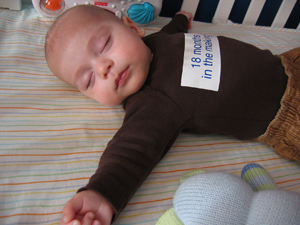When my son was a newborn, I struggled to figure out how to feed myself and my husband—breastmilk and formula took care of our boy. Stephen and I ate far too many meals of takeout or fried egg sandwiches, while junior guzzled eight meals a day. Finally, once he settled down into a napping routine, I figured out how to get back in the kitchen without falling asleep in the soup pot: Nap-Time Cooking. The idea’s pretty simple. Once the wee’un dozes off, you hit the kitchen for 10 to 15 minutes of prep. Then you nap. Next time the kid conks out, you do the recipe’s next few steps. And again you nap. See how this works? It’s a beautiful thing. (If you’d like to see Nap-Time Cooking in an actual recipe, check out Corn, Peach, Tomato Over Grilled Polenta or (Relatively) Low-Fat Chicken Pot Pie.)
Maybe you’ve got a favorite recipe of your own that seems too complex to pull off now that baby’s here, but you think it just might work for Nap-Time Cooking. Dollars to donuts, you’re right. Here’s how to do it:
- Nap 1 is generally devoted to prep: Measure out any spices and put them into small bowls. Wash, peel, and chop vegetables and herbs—one of the few I’d recommend leaving for later is fresh basil, which turns black after being chopped. After being cut, firm, dry vegetables can remain at room temperature for hours. If it will be more than two hours before you move on to Stage 2, prepared vegetables that are moist or juicy (including sprouts and washed and cut leafy greens, fresh herbs, onions, and tomatoes) should be refrigerated. Refrigerate cut onions in an airtight container, or the odor might infiltrate all your other food! Acid deters the growth of bacteria, so naturally acidic items like citrus fruits are considered safe at room temperature. All proteins must be refrigerated.
- Nap 2, if you’re lucky enough to have a triple-napper, is for intermediate preparation: browning or marinating meat, and preliminary cooking of vegetables. All protein must go back into the fridge (in a clean container to avoid cross-contamination), and if you’re softening vegetables in the pan drippings the whole pot should be cooled slightly, then refrigerated. Roasted or sautéed vegetables that haven’t touched protein are fine at room temperature; just remove from heat, cover, and set aside. If you don’t have three naps to work with, skip the packing up & refrigerating and move right on to the next steps.
- Nap 3 is for the final cooking—assembling, baking (remember to preheat the oven, about 20 minutes before you plan to start), simmering on the stove, tossing with the remaining ingredients. If you've refrigerated the pot, try to remove it from the fridge at least ten minutes before you start cooking, and be sure to reheat gently, over a low flame, before resuming the recipe.
A FEW WORDS ABOUT FOOD SAFETY
To ensure that my Nap-Time Cooking technique follows all current food safety guidelines, I spoke to an expert: Catherine Strohbehn, PhD, RD, CP-FS, and HRIM Extension Specialist at Iowa State University. (confused? RD = Registered Dietician; CP-FS = Certified Professional-Food Safety; HRIM = Hotel, Restaurant, and Institution Management.)
Here’s Dr. Strohbehn’s advice:
- In general, refrigerate semi-prepared foods that will go more than two hours between stages. There are two exceptions:
- Since bacteria need moisture to thrive, vegetables with dry surfaces (like carrots, sweet potatoes, and winter squash) are considered safe at room temperature.
- And once cooked, just about any vegetable should be fine at room temperature for a couple of hours, as long as it hasn’t touched protein—especially if you’ll be cooking it again in later stages, when heat above 165° will kill off much of the bacteria.
- The temperature “danger zone” for cooked foods is between 70° and 135°—foods should stay in this range for no more than two hours.
- Any protein that will be at room temperature for more than two hours must be refrigerated. This includes pan drippings.
For this reason, be extremely careful about cross-contamination. Use a separate cutting board and knife for animal proteins. If any vegetables or other ingredients come in contact with the meat, the board, the knife, or even drippings, those ingredients must be refrigerated, too. After browning meats, don’t return them to the original packaging—use a clean container.
I'm sure I don't have to point out that this technique works best for moms on maternity leave, stay-at-home moms, and work-from-home moms. If you have an office job, try it on the weekend!
Having trouble breaking down a recipe? Leave a comment and I’ll do my best to help you sort it out.



The views and opinions expressed in this post are those of the author(s) and do not necessarily reflect those of MomsRising.org.
MomsRising.org strongly encourages our readers to post comments in response to blog posts. We value diversity of opinions and perspectives. Our goals for this space are to be educational, thought-provoking, and respectful. So we actively moderate comments and we reserve the right to edit or remove comments that undermine these goals. Thanks!